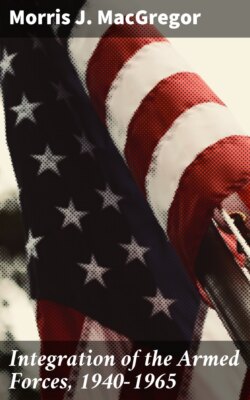Читать книгу Integration of the Armed Forces, 1940-1965 - Morris J. MacGregor - Страница 42
На сайте Литреса книга снята с продажи.
New Directions
ОглавлениеAll the services developed new racial policies in the immediate postwar period. Because these policies were responses to racial stresses peculiar to each service and were influenced by the varied experiences of each, they were, predictably, disparate in both substance and approach; because they were also reactions to a common set of pressures on the services they proved to be, perhaps not so predictably, quite similar in practical consequences. One pressure felt by all the services was the recently acquired knowledge that the nation's military manpower was not only variable but also limited in quantity. Military efficiency demanded, therefore, that the services not only make the most effective use of available manpower, but also improve its quality. Since Negroes, who made up approximately 10 percent of the population, formed a substantial part of the nation's manpower, they could no longer be considered primarily a source of unskilled labor. They too must be employed appropriately, and to this end a higher proportion of Negroes in the services must be qualified for specialized jobs.
Continuing demands by civil rights groups added to the pressure on the services to employ Negroes according to their abilities. Arguing that Negroes had the right to enjoy the privileges and share the responsibilities of citizenship, civil rights spokesmen appeared determined to test the constitutionality of the services' wartime policies in the courts. Their demands placed the Truman administration on the defensive and served warning on the armed forces that never again could they look to the exclusion of black Americans as a long-term solution to their racial problems.
In addition to such pressures, the services had to reckon with a more immediate problem. Postwar black reenlistment, particularly among service men stationed overseas, was climbing far beyond expectation. As the armed forces demobilized in late 1945 and early 1946, the percentage of Negroes in the Army rose above its wartime high of 9.68 percent of the enlisted strength and was expected to reach 15 percent and more by 1947. Aside from the Marine Corps, which experienced a rapid drop in black enlistment, the Navy also expected a rise in the percentage of Negroes, at least in the near future. The increase occurred in part because Negroes, who had less combat time than whites and therefore fewer eligibility points for discharge, were being separated from service later and more slowly. The rise reflected as well the Negro's expectation that the national labor market would deteriorate in the wake of the war. Although greater opportunities for employment had developed for black Americans, civilians already filled the posts and many young Negroes preferred the job security of a military career. But there was another, more poignant reason why many Negroes elected to remain in uniform: they were afraid to reenter what seemed a hostile society and preferred life in the armed forces, imperfect as that might be. The effect of this increase on the services, particularly the largest service, the Army, was sharp and direct. Since many Negroes were poorly educated, they were slow to learn the use of sophisticated military equipment, and since the best educated and qualified men, black and white, tended to leave, the services faced the prospect of having a large proportion of their enlisted strength black and unskilled.
